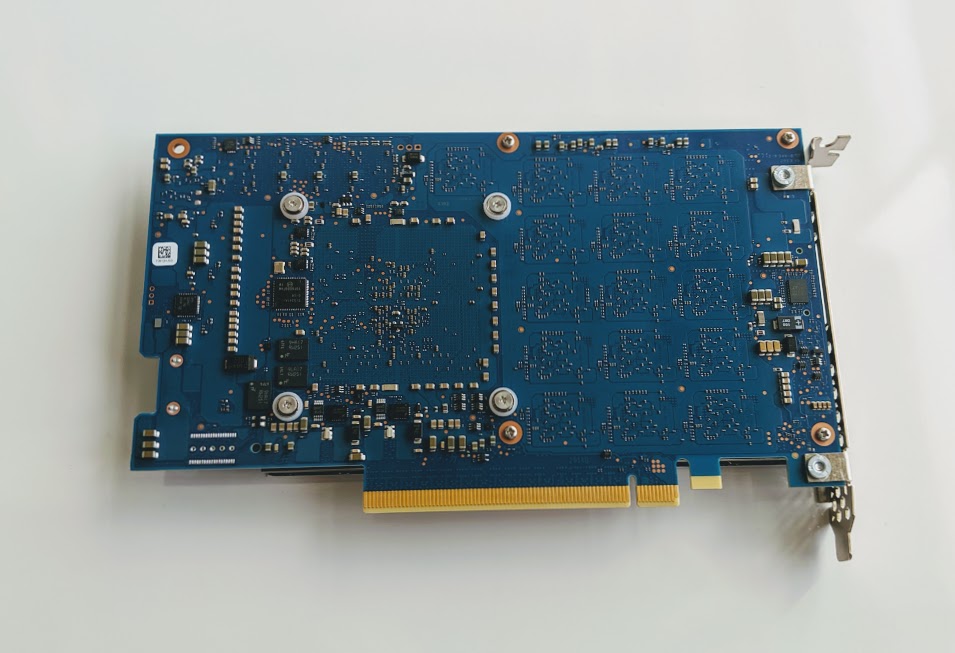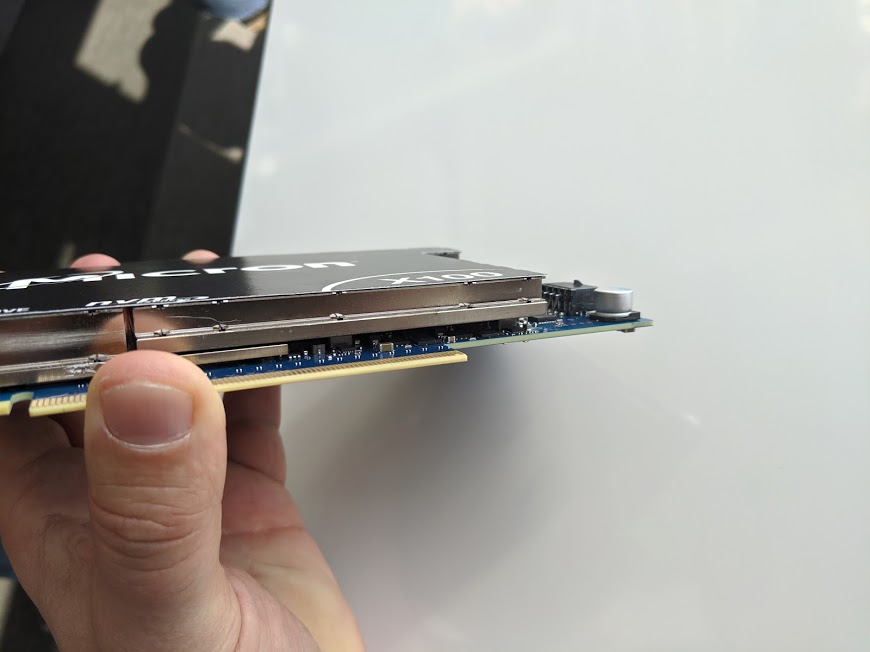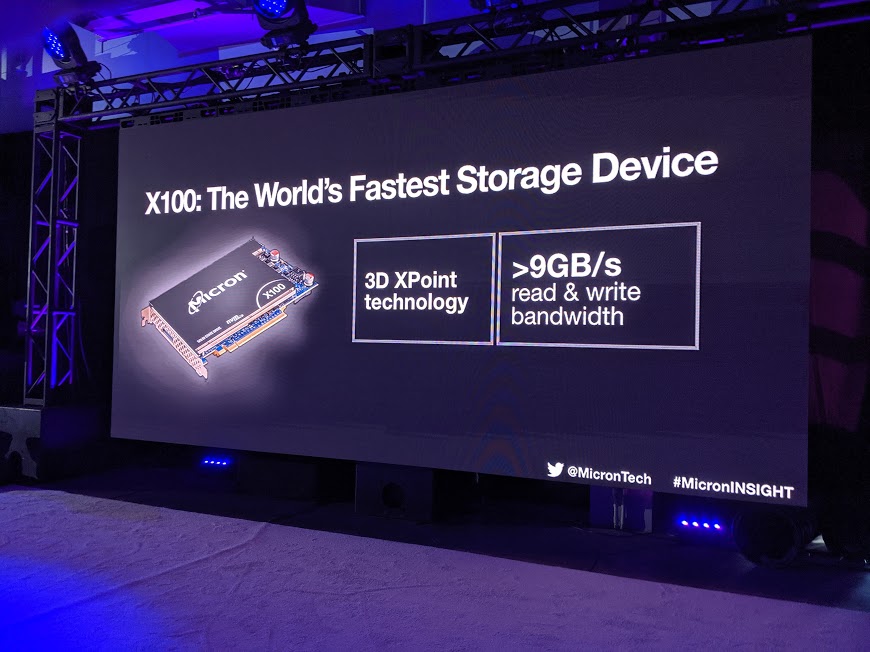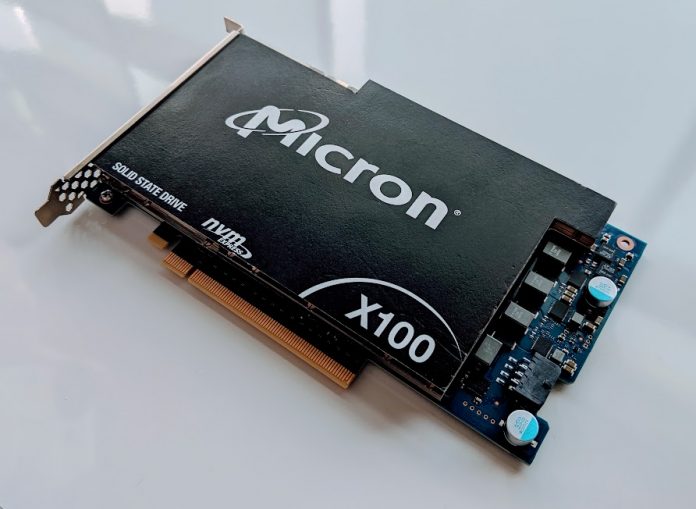At Micron Insight 2019 in San Francisco, we got to see something very interesting, Micron’s first 3D XPoint drive. The Micron X100 is a NVMe SSD with a twist. It is a PCIe x16 device that Micron claims are the world’s fastest SSDs.
Micron X100 3D XPoint PCIe x16 NVMe SSD
We were able to take a few photos of the Micron X100 SSD at the show. We are going to post these at the embargo time, then update with more of the drive’s details as the company releases them. You can see the PCIe x16 full-height device in the cover image. In contrast, the Intel Optane 905P / P4800X are low profile devices. You can see that there is even an auxiliary power connector on the board.

You can see on the backside of the PCIe card a relatively blank layout. You can see near the I/O plate an array of at least 16 3D XPoint packages. The left side of this picture has a giant component that looks like it is a very large ASIC, FPGA, or PCIe switch. Micron says this is a custom controller but did not talk about what kind it was. Seeing it in person, it is large.
Here is a look at the controller, under the heatsink that covers nearly the entire card.

Before the keynote, I was able to hold one of the devices. The passive cooling is designed for servers like the Dell EMC PowerEdge R740xd.

The PCIe x16 interface is four times what the current crop of Intel Optane PCIe NVMe SSDs have. It has over 9GB/s of read and write bandwidth. Micron claims up to 2.5 million random read/ write IOPS as well.

As a result, Micron can scale bandwidth much higher. This has another key benefit, it will become the high-performance storage option for AMD EPYC which has more PCIe lanes than current Intel Xeon platforms.
We will post more as we get it. Capacities were not mentioned in the keynote. Still, the drive that was announced today is not simply a render. I had a card in my hands.
Update 2019-10-24: We confirmed with Micron that this is a PCIe Gen3 x16 device, not a Gen4 device. Micron declined to state which generation of 3D XPoint it is.
I asked the question “does this card present itself as a single logical device?” The Micron representative declined to answer but said “that is a good question.”
The reason I asked the question is that the chip underneath the heatsink could also potentially be a PCIe switch device. If that is the case, there is an outside chance that this device presents itself as four logical devices even though it is one physical card.
Update 2019-10-25: Rumor has it this is 2nd generation 3D XPoint. Micron’s official Twitter account even “Liked” that rumor.






When are you guys getting them? You have all the Optane DIMMs and NVMe drives.
At 9 GB/s for a x16 bus it seems to be using PCIe 3.0. Not getting why they aren’t moving to 4.0 with an unreleased product, especially if they are aiming it at EPYC Rome platforms. Maybe I’m wrong and that bandwidth number is lower because of what the xpoint dies are capable of?
Confirmed that it is a PCIe Gen3 device in the update.
Like! I have been wondering what happened to Micron with XPoint, & sincerely hope this is not tied down to Intel only.
In the past few days we’ve seen the 7300 and 5300 series launched and this announced, all with PCIe 3.0 instead of 4, even tho some of them aren’t released yet, and intel is going to have 4.0 capable parts next year, iirc. It really shows how far AMD has to go in the server market. Seems like almost no enterprise drives with 4.0 will be out before there are Xeons on the market that support the standard. It’s frustrating, I’m looking to buy a $25k server for deep learning for my lab and I’m going to get one with an EPYC CPU, and it’s going to come with drives that don’t take advantage of PCIe 4.0, because there aren’t any enterprise ones available.
https://blueequity.io/article/4351/Micron-Technology–MU–Discusses-Acquisition-of-Intel-s-Interest-in-IM-Flash-Technologies-LLC-Broker-Conference-Call–Transcript–
They never had plans to bring first gen to market only second gen. So this is 99% second gen xpoint
That’s a very good point Bryan S. Also While PCI gen 4 would have been nice I can understand why they did not go that route. By the time Intel servers upgrade from PCI gen 3 this product will likely be replaced with an upgrade gen 2 version. For the current (still relatively few) AMD severs obviously support PCI 4 but have PCI lanes to spare (at least comparatively).
Also second gen 3D Xpoint tech is already cutting edge and new. It’s not hard to see why they would not launch a product with two new emerging technologies on one device for the enterprise market. Also look at the current card. It is already a full size PCIe card compared to the more industry standard low profile PCIe ssds. Along with a massive mystery chip and auxiliary power connector. I would be shocked if making this device with PCIe gen 4 would not at the very least increase size of the main chip along with the overall size of the card to the chip and a larger passive cooler or require active cooling in most cases.
Where can you buy this?
8us latency
9GB/s
read IOPs 2,35M
write IOPs 1,95M
128 I/O queue pairs
from twitter MicronStorage/status/1192529330477391873/photo/1
for comparison intel P4800x
10us latency
2,5GB/s
read IOPs 0,55M
write IOPs 0,55M